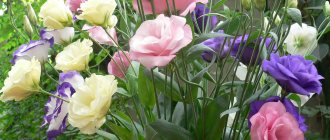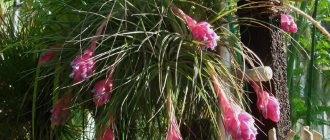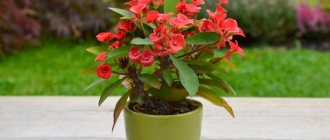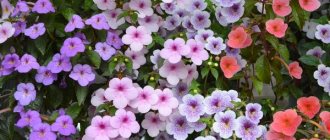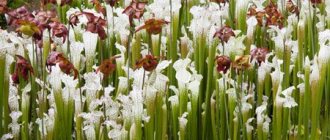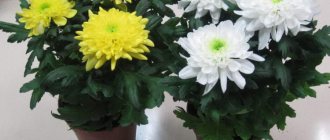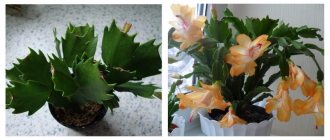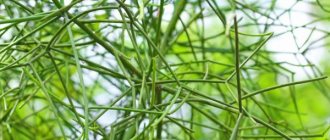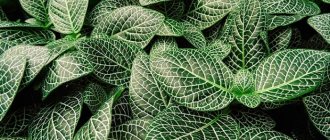Author: Natalya Category: Houseplants Published: March 02, 2019Republished: February 02, 2019Last edits: January 11, 2021
- Growing from seeds
- Tillandsia usneoides
Tillandsia (lat. Tillandsia) is the name of a genus of herbaceous evergreen epiphytes of the Bromeliad family, which, according to various sources, numbers from 400 to 700 species. In nature, these plants can be found in the American tropics and subtropics - in Argentina, Chile, Central America, Mexico and the southern states of the USA. The genus was named in honor of Elias Tillands, a famous Finnish botanist: Carl Linnaeus reproached Charles Plumier for calling the plant a barbaric American name (Caraguata), and gave the genus the name of the first and only famous botanist from Finland. Today, some species of the genus Tillandsia have become popular in indoor culture.
Planting and caring for tillandsia
- Flowering: usually in summer, sometimes for several months, but after flowering the rosette dies.
- Light: Green-leaved species require bright, indirect light from March to September and direct sunlight from October to February, but can grow in partial shade. Plants with silver leaves should be kept in partial shade at all times.
- Temperature: in summer – 22-30 ˚C during the daytime and 15-18 ˚C at night, in winter – within 14-15 ˚C. The upper temperature threshold for tillandsia is 34 ˚C, the lower is 10 ˚C.
- Watering: melt, rain or filtered water at a temperature of at least 20 ˚C is poured into the center of the rosette formed by the leaves. In summer, watering is frequent, in winter - rare. The substrate is watered only after it has completely dried.
- Humidity: Plants with green leaves require daily spraying and moistening with water. Twice a month, wash this tillandsia under a warm shower. Particularly moisture-loving species can only live in a florarium.
- Fertilizing: once every month and a half from September to March, a fertilizer solution for orchids or for bromeliads, which does not contain copper and boron, is added to the outlet with irrigation water. The concentration of the solution should be four times weaker than indicated in the instructions.
- Dormant period: in some species it begins in winter, but in most plants this period is not clearly expressed.
- Replanting: epiphytes do not need replanting, and plants with green leaves are replanted once every 2-3 years, but the top layer of substrate in their pots should be renewed every spring.
- Reproduction: seeds and children.
- Pests: Mealybugs, whiteflies or scale insects.
- Diseases: viral and fungal infections from improper care.
Read more about growing tillandsia below.
Conditions for growing at home
As already mentioned, tillandsia is remarkable in that it can be placed in all kinds of containers and even simply attached to any hard surface. However, caring for atmospheric tillandsias is more difficult than caring for plants grown in pots.
Location
Whatever container or support you use for tillandsias, the first thing to remember is that the bottom to which the plant is attached should be lined with materials such as:
- bark (including pine);
- moss;
- coir.
Trendy methods of placement on crystals, in glass balls, shells look impressive, but we must not forget about the comfort for the plant. “Atmospheric plants” do not grow well on smooth, slippery, non-breathable surfaces, so it is better to create a cozy “nest” for tillandsia. The popular placement of flowers on wine corks is not justified due to the slow growth and tendency for flower rosettes to become smaller. Tillandsia also does not adapt well to being attached to beech and oak branches and blocks.
The list of the best possible growing locations includes:
- Pine branches. In this case, a layer of coconut fiber is laid between the branch and the flower, or a mini-nest made of synthetic materials is attached to the branch, which help retain moisture and ventilation.
- Hanging plastic pots.
- Baskets made of bamboo/spruce/willow/sycamore/jute.
- Mesh pots.
- A wall panel made of pine bark with a tillandsia plant attached to it.
- Coconut kernels.
- Aquariums (never closed, for air circulation).
The most common way to attach tillandsia to a support is by screwing it with a PVC-sheathed binding wire. It retains its shape well, does not rot, does not slip. It is not recommended to use glue, even special floral glue, as it blocks the pores of the plant, which can cause the death of the flower.
Temperature
In general, tillandsia tolerates the microclimate of city apartments well.
The basic temperature requirements are as follows:
- No sudden changes.
- The air temperature is at least +18 °C (but can withstand a short-term drop to +12 °C).
- Regular access to fresh air, ventilation (without strong drafts).
- In summer it can be placed outdoors, protected from precipitation.
Lighting
Proper lighting plays an important role in growing these plants. Unlike potted tillandsias, “atmospheric” ones do not require too bright light; direct sunlight is unfavorable for them. Placement in partial shade, diffused or completely artificial lighting is quite suitable for them. In any case, the distance from the plant to the light source should not be less than 90 cm.
Air humidity
Being tropical plants, tillandsias require consistently high air humidity, at least 70–80%, due to moisture adsorption by the leaves
Increased attention should be paid to this factor in winter during the period of functioning central heating. It is better to use humidifiers at this time
This is especially true for those varieties that grow in areas with very high humidity (for example, violet-flowered tillandsia). Typically, these species have very delicate, thin leaves. Some gardeners grow epiphytic tillandsias in the bathroom. However, the leaves should not be allowed to be constantly wet, otherwise the flower will get sick.
Botanical description
The genus Tillandsia is an evergreen or terrestrial epiphyte. The differences between species of the genus are sometimes striking, so it is difficult to give an accurate description of a representative of the genus. Most of the species of the genus parasitize on stones and trees, absorbing nutrients and moisture from them with their root system. Some members of the genus have a more or less developed stem with spirally arranged leaves, while other species do not. In some representatives of the genus, the leaves are gray, elongated, narrow and covered with scales that absorb moisture from the air, while in others they are dark green, sometimes with a red-brown tint, partially covered with scales, leathery, slightly curved and forming a rosette, in the center of which grows oval, spike-shaped inflorescence with bright large bracts, arranged in two rows and closely overlapping each other. And there are species with flat, smooth and long leaves of bright green color. Tillandsia flowers are small, tubular, with pointed petals. Tillandsia blooms in July-August. After flowering, the mother plant dies, but before that it forms new shoots. The Tillandsia flower grows slowly.
When and how does it bloom
Tillandsia atmospherica blooms once at the age of 2-3 years, after which it begins to reproduce, sending out shoots and, having devoted all its strength to it, dies.
Types of flowers
Tillandsia blooms unusually and beautifully. First, she produces a spike, on which bright buds subsequently bloom one by one. The size and color of the buds depends on the type of flower.
Incredible tillandsia bloom
Flower shapes
The buds of the ear bloom one after another, while the faded buds are not picked, as they look exotic and decorative.
Flowering period
The total duration of flowering can last several months. During the flowering period, you need to monitor air humidity and the condition of the leaves, and carry out regular spraying so that the plant has enough strength to bear offspring.
You should know! The plant, along with its support, is regularly immersed in water, which is why it is better to immediately choose a reliable material for support that will not quickly deteriorate from the abundance of moisture.
Types of flowers
The ear buds bloom one after another. The bracts come in pink, purple, red, yellow, orange, and lilac, making tillandsia always look dazzling.
Flower shapes
Tillandsia produces a bright peduncle, usually raspberry-pink in the shape of a spike. Each flower consists of three petals in bright blue, indigo or violet shades. Flowers bloom one by one. During this period, up to 20 of them can open. They fade quickly. As they dry, they are cut off.
Flowering period
It blooms in summer, less often this can happen in autumn and even winter. The process of opening the buds can last up to two or more months. At this time, monitor the moisture and condition of the leaves.
Tillandsia in bloom
Additional Information! Varieties without roots bloom once during their existence, and this happens two or three years after planting. When forming buds, they devote all their energy to the formation of young shoots, but they themselves die.
Caring for tillandsia at home
Growing conditions
The indoor flower Tillandsia is not capricious. Caring for tillandsia at home is so simple that even a novice gardener can handle it, but growing these plants has its own nuances.
For convenience, Tillandsia species can be divided into two groups:
- group A (atmospheric species) – capricious plants with gray (silver) leaves;
- group G (potted species) – plants with green leaves.
For plants of group A, a place in partial shade is suitable, or, in extreme cases, in the shade, and for tillandsias of group G, from March to September, bright but diffuse lighting is required, and from October to February they need direct sunlight. As a last resort, you can place these plants in partial shade.
- Araucaria - care, photos, types
The temperature of all tillandsias in summer is 22-30 ºC during the day and 15-18 at night, in winter – not lower than 14-15 ºC. The permissible maximum temperature is 34 ºC, and the permissible minimum is 10 ºC, although tillandsias can tolerate a temperature drop of up to 4 ºC for a short time.
The air humidity in the room with tillandsia should be maintained at 60%. To do this, from March to September, it is advisable to spray the tillandsia with soft water three times a day, taking care not to let the splashes fall on the inflorescences. In the remaining months of the year, spraying is carried out once a day in the morning. The water should evaporate from the leaves of the plant within 4 hours.
The room in which tillandsia grows must be ventilated frequently, but drafts must not be allowed to occur.
Tillandsia at home can grow in a pot or on an epiphytic tree - depending on the type of plant. Atmospheric varieties with a small number of roots are best grown on a pole or snag with remnants of bark. In this case, the epiphytic species of tillandsia will receive nutrition and moisture from the bark and the environment, and watering can be completely replaced by spraying.
Watering
The tillandsia plant requires a special method of watering: water must be poured into the center of the rosette of leaves. Due to the increased sensitivity of tillandsias to chlorine, tap water is not suitable for moisturizing them, nor is distillate suitable for them. Watering should be done with melt or rain water, the temperature of which should not be lower than 20 ºC. For group A, daily spraying of the above-ground part of the plant is sufficient, and watering of the substrate is carried out only after it has completely dried. As for plants of group G, daily spraying is not enough - the substrate must be kept constantly moist in the summer, and in winter it can be allowed to dry out a little.
If there is not enough light in the room and the temperature is lower than necessary, then the intervals between watering the substrate are increased, but daily spraying of the leaves should be continued in any case. Excess water from the trays is drained, since the plant may die in stagnant water. If you allow the substrate to dry out completely, soak it in water for a day.
Twice a month, your homemade tillandsia should take a warm shower - you need to wash away the dirt from the axils of the leaves in which water stagnates. However, when taking a shower with the plant, as well as when spraying, you need to ensure that water does not get on the bracts, as this can sharply shorten the flowering time of tillandsia.
Fertilizer
Caring for tillandsia involves applying fertilizer for orchids or special fertilizer for bromeliads that does not contain boron and copper, which poison tillandsia. The concentration of the nutrient solution should be four times weaker than that specified by the manufacturers. Fertilizers are applied from March to September, simultaneously with watering, directly into the tillandsia outlet. Some species are best fed by leaves. The frequency of feeding is once every six weeks.
Transfer
Tillandsia is replanted once every 2-3 years, and only species with green leaves - epiphytic plants do not need replanting. However, the top layer of substrate in pots needs to be updated annually. You can determine that indoor tillandsia needs replanting based on the following signs:
- the plant stops blooming;
- the root system begins to crawl out of the pot.
Tillandsia is replanted in the spring, completely replacing the substrate. It is preferable to take a low but wide pot, and a loose and permeable mixture of four parts earth with humus, one part moss, one part coarse sand and one part peat is suitable as a substrate. Tillandsia also grows well in a soil mixture consisting of equal parts of deciduous soil, peat and humus with the addition of sphagnum, fern roots and pine bark. You can also use commercial soil for orchids or bromeliads. Be sure to place charcoal drainage at the bottom of the pot. How to replant tillandsia? Very carefully remove the plant from the old pot, freeing the root system from the old substrate, and transplant it into a new pot, lightly pressing down the soil and trying to give the plant stability. After transplanting, water your tillandsia.
Tillandsia blooming
Tillandsia flowers are varied - their bloom can last several months, or may end in a few days. Their coloring also differs in a variety of colors - orange, pink, white, blue, lilac, violet, bright yellow, crimson, red... There are species that bloom willingly, and there are those that need to be forced to flower using growth regulators, for example, Zircon.
Flowering usually occurs in the summer, but sometimes various factors interfere with the development of the plant, so you can see the formation of a peduncle at other times of the year.
How to replant?
Monocarpic species are replanted only once, after purchase in the store. Polycarpic plants are replanted in the spring, every two to three years. A thick layer of drainage is placed at the bottom of the pot, to which it is advisable to add charcoal.
The plant is carefully removed from the old pot, freeing its roots from the soil, and placed in a new pot. It should be wide and shallow, since the root system of a tropical plant is poorly developed. It is best to take a clay or ceramic container. If you use a plastic pot, then you need to make a lot of holes in it.
Every year in spring, the top layer of the substrate is changed.
Tillandsia propagation
Tillandsia propagates by seeds and vegetatively.
- Bromeliad at home: care and types
Growing from seeds
It is better to buy Tillandsia seeds of group G in the store. A substrate consisting of sand and peat is placed in a container for germinating seeds. The seeds are laid out on the moistened substrate without embedding them in the soil, after which the crops are covered with a transparent film or glass, placed in a bright place and kept until germination at a temperature of about 25 ºC. Seeds can germinate in a month or even later, but you should expect tillandsia to bloom no sooner than after 5 years.
Reproduction by children
During the flowering of tillandsia, side shoots - children - begin to form. After flowering, the mother rosette dies, and in order to save the plant, you need to plant shoots from it that have already formed their own roots and reached a height of 10 cm. They are rooted in a mixture of sand and peat, taken in equal parts. The process lasts 2-3 months, after which the rooted children are transplanted to a permanent place in soil mixture for orchids. If the plant has only one shoot, then the mother rosette is removed after flowering, and the baby is left to grow in the same soil.
Atmospheric tillandsias reproduce by division into bunches. The divisions are inserted into supports with moist sphagnum, where they continue to grow.
Bloom
Atmospheric tillandsia blooms once in its life, and this happens when the plant is two or three years old. And after the formation of buds, the tropical guest spends all her energy on the formation of children, and she herself dies. The flowering of tillandsia looks very exotic: the plant produces a spike, on which brightly colored buds open one by one. Each of them does not last long, but the flowering itself can last for several months. In addition, the ear looks very decorative, even after the last bud leaves. Therefore, it is not necessary to cut it out, because over time it will die along with the mother plant.
Caring for tillandsia during and after flowering is no different from usual. It is necessary, as before, to regularly spray and water the flower so that it grows more children. Each specimen produces from 3 to 8 lateral shoots, thanks to which you can create a large collection of these exotic plants.
Pests and diseases
Healthy, strong plants are rarely affected by diseases or pests, but a tillandsia weakened by replanting or poor care can be occupied by mealybugs, whiteflies or scale insects. To rid the plant of pests, wash it with soapy water, then let the tillandsia dry and treat it with an insecticide - Actellik or Karbofos. If there are a lot of pests, you will have to repeat the treatment. In total, you can spray the plant with insecticides up to 4 times, maintaining an interval of 10 days between treatments.
Sometimes tillandsia may develop a fungal disease that occurs as a result of violation of maintenance conditions. A sign that the plant is affected by a fungal infection are dark spots on the leaves of tillandsia. In this case, treat the plant with a solution of a fungicidal drug - for example, Fundazol.
Troubles for the plant occur in addition to pests and diseases. For example, if the leaves and bracts of a tillandsia plant begin to turn pale, or the leaves begin to curl, wrinkle, or die off, turning brown, these are most likely signs of dehydration.
Dropped leaves indicate that the plant has suffered stress due to sudden temperature changes or fluctuations in light, but it can also be a sign of rotting.
Brown spots on the leaves may appear due to sunburn.
If the plant dies and the leaves become covered with limescale, this is due to the fact that it was watered with hard water.
From excessive watering, the rosette of tillandsia becomes soft and falls apart, and the leaves become brown or brown.
Lack of flowering, depressed appearance (loss of leaf turgor, discoloration) can be a consequence of sudden and repeated temperature changes.
If the color of the leaves begins to fade, we can conclude that the plant suffers from excess light, and from a lack of light, the color of the leaves, on the contrary, becomes darker, the growth of the plant slows down, and the bract does not form.
Brown leaf tips are a symptom of lack of moisture, drafts, overcooling or watering with hard water.
Possible problems in growing
Do not forget that the flower comes from the tropics and requires attention, care and the creation of favorable microclimatic conditions. Unfortunately, the use of fungicides and insecticides is prohibited. The flower cannot tolerate the effects of poisons and dies. It is better to prevent a disease than to cure it.
Pests
Scale insects and spider mites often appear on the plant. They are combated by regular and thorough washing of the bush. In especially severe cases, it is possible to use a soap solution.
Tillandsia silver
Among the diseases, leaf spot is the most common. In this case, small transparent drops first appear on the leaves, which over time turn into brown spots that gradually take over the plant. The diseased flower is thrown away.
Other problems
When growing a foreign mystery flower, some problems may arise, for example:
- Tillandsia does not bloom - perhaps the plant does not have enough heat or light and just needs to be moved to another window;
- the leaves have curled into a spiral and their tips have dried out - there is not enough moisture, the spraying schedule should be changed;
- the leaves have become soft - the plant is cold, the room temperature needs to be increased;
- there are no daughter shoots - the branch does not have enough nutrition, it needs to be fertilized.
Tillandsia maquiforma
Types and varieties
The most popular types of atmospheric tillandsias (group A) include:
- Alocasia at home
Tillandsia usneoides
Popularly called “old man’s beard” or “Spanish moss”. Plants of this species have thin stems, reaching several meters in length, and thread-like, double-rowed leaves up to 10 mm wide and up to 5 cm long. The reflective scales covering the stems and leaves make them appear silver or gray. The plant does not have a root system. It hangs from branches and stones like a lacy cascade. At home, there is no need to secure the plant to a support; just hang it so that it grows downwards. In the summer, the usnee-like tillandsia blooms with yellowish-light green flowers;
Tillandsia tricolor
It is a compact epiphyte with linear leaves of a gray-green hue, forming a wide rosette. The long peduncles of this plant are distinguished by bright bracts - red in the lower part, yellow in the middle and light green in the upper part. The bracts contain purple flowers;
Tillandsia stricta
Resembles a bright green tuft of grass. This is an epiphyte that forms a dense rosette of narrow triangular leaves up to 20 cm long and up to 1 cm wide, covered with gray scales. Short curved peduncles end in a dense spike-shaped inflorescence with oval pink bracts arranged in a spiral and purple inconspicuous flowers;
Jellyfish head (Tillandsia caput-medusae)
This is an epiphytic plant, similar to a squid, jellyfish or octopus. Its tightly closed light gray leaves form the base of the bulb, bending only at the top. They stick out in different directions, creating bizarre shapes. The water that accumulates in the bulb drains from the leaves. When flowering, the jellyfish head produces a panicle of several spikelets with grain-like red bracts and narrow-tubular blue-violet flowers that contrast the bracts;
Silver Tillandsia (Tillandsia argentea)
It can also be called filamentous or hair-like; it is an epiphyte with long, narrow, curved or spirally wrapped leaf blades that expand towards the base, which grow in a bunch from the base of the shoots. From the outside, this plant looks like a dried cereal;
Tillandsia ionantha
Reminiscent of corals, forming small rosettes of claw-like curved silvery-green leaves, above which rise bluish-purple spike-shaped inflorescences. During flowering, the upper leaves in the rosettes turn red and look like part of a strange flower;
Tillandsia andreana
An epiphytic plant, sometimes stemless and sometimes forming a long leafy stem. Its curled or straight linear leaves are covered with ash or brown scales. The plant does not form a peduncle, and its apical inflorescence consists of one or two flowers. The pointed lanceolate bracts are bare, as are the elliptical sepals, reaching a length of 4 cm. This plant blooms in April-May.
Of the green tillandsias (group G), the following species are most often grown in indoor culture:
Blue Tillandsia (Tillandsia cyanea)
Which is perhaps the most popular type of green tillandsia - only blue tillandsia hybrids are more popular. The plant forms a kind of rosette of leaves, similar to the leaves of cereals with changing colors: at the base they are reddish, and then become brownish-striped. The plant reaches a height of 20 to 30 cm. In summer, a flattened spike with ornamentally arranged dense lilac or pink bracts that look like artificial ones begins to develop in the center of the rosette. Quickly fading tillandsia flowers of a blue hue with bent diamond-shaped petals bloom gradually from the top to the base;
Tillandsia lindenii
Similar to blue Tillandsia, but somewhat more graceful. Its spike is not so flat, the bracts are colored in red or pink shades. The flowers are also blue, grass-like leaves, thinner than those of Tillandsia blue, form loose rosettes;
Tillandsia dyeriana
This beautiful and elegant plant has an inflorescence that resembles a yellowed acacia leaf. Densely arranged flat and long tongue-shaped leaves forming a rosette, as if wrapped around the base of the flower shoot. A thin peduncle crowns a symmetrical inflorescence with double-rowed oval leaf-shaped bracts of red or orange color;
Tillandsia Anita
Tillandsia blue hybrid, the most popular plant in indoor culture. It is very beautiful: scaly, narrow and pointed leaves form a rosette, in the center of which a blue flower blooms on a short stem, surrounded by lilac or pink bracts. The flower fades quickly, but its bracts remain bright for a long time, gradually turning green;
Tillandsia recurvata
It is an evergreen herbaceous plant with a branching or single stem, two-row linear cylindrical leaves, bent or twisted, and densely dotted with ash scales. The peduncle covered with linear-lanceolate leaves reaches a height of 13 cm. The inflorescence is dense, consisting of 1-2 white or pale purple flowers. The bracts are densely pubescent. The plant blooms at any time of the year;
Tillandsia bulbosa
Epiphyte with 8-15 leaves with spherically swollen sheaths, sharply turning into twisted subulate plates. The leaves are covered with gray scales, and a straight peduncle is crowned by an inflorescence with reddish leaves, consisting of green or red spikelets. The bracts are oval, pointed, the flowers are sessile with blue or purple pointed linear petals. The plant can bloom at any time of the year.
Reviews
Atmospheric tillandsia is becoming increasingly popular among domestic gardeners. And users leave positive reviews about it. They note that the plant is unpretentious and does not cause much trouble. In addition, it looks very impressive and original, and becomes a living decoration of any interior. The only disadvantage is the requirement for high air humidity. But this problem can be solved in simple and accessible ways.
Provide proper care for atmospheric tillandsia at home, and it will definitely reward you with rapid growth and an attractive appearance. To do this, adhere to the basic rules for growing this crop, and strictly carry out the necessary agrotechnical measures.
Source: fb.ru
